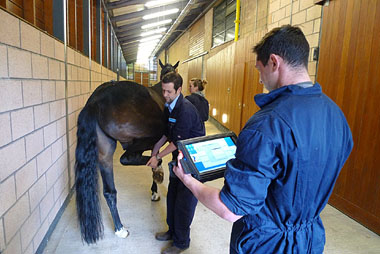New Research Shows Equine Lameness Can Be Measured
 11 years ago
11 years ago  1628 views
1628 views
Posted
23rd May, 2013 20h29
 Flexion testing, using the sensor-based system, at the University of Glasgow's School of Veterinary Medicine
For many years, opinions on the value of flexion tests in assessing equine lameness have been divided but now new research looks set to turn what has always been regarded as a subjective process into a wholly objective one. The comprehensive study, recently published in Equine Veterinary Journal’s (EVJ) in partnership with the American Association of Equine Practitioners, has shown that a wireless, inertial sensor-based system can effectively measure the horse’s response to a flexion test.
Flexion tests are used routinely in horses with subtle or imperceptible lameness, to exacerbate the problem and make it apparent to the observer. The test involves applying a short period of pressure to the joints of the limb before re-examination, and evaluating any change in gait. However, flexion tests rely on the ability of the observer to identify and interpret changes in the horse’s gait and in that respect these tests are subjective and not necessarily consistent between observers.
The research study was conducted by orthopaedic surgeons based at the University of Glasgow's School of Veterinary Medicine1. A total of 17 healthy adult horses, all in work, were fitted with sensors before being trotted in a straight line. The sensors measured vertical pelvic movement asymmetry for both right and left hind limb strides and the average difference in maximum and minimum pelvic height between right and left hind limb strides. A hind limb was randomly selected for 60 seconds of proximal flexion, after which the horse was trotted for a minimum of 10 strides. Response to the flexion was blindly assessed as negative or positive by an experienced observer.
John Marshall, lecturer in equine surgery at the University of Glasgow, who led the study, concluded: “A positive response to flexion resulted in significant changes to objective measurements of pelvic symmetry, supporting the use of inertial sensor systems to objectively assess response to flexion tests.”
Professor Jim Moore, North American Editor of the EVJ, continued: “The introduction of an objective approach to documenting lameness examination will not only help vets and trainers to investigate equine lameness more accurately. It will also serve as an unbiased method of communicating lameness examination findings among vets, trainers, farriers and other professionals.”
The next phase of research will be to establish cut-off values for objective assessment of other equine lameness diagnostic procedures, such as nerve blocks.
Use of a wireless, inertial sensor-based system to objectively evaluate flexion tests in the horse, JF Marshall, DG Lund and LC Voute, EVJ ISSN 0425-1644 DOI:10.1111/j.2042-3306.2012.00611.x
Flexion testing, using the sensor-based system, at the University of Glasgow's School of Veterinary Medicine
For many years, opinions on the value of flexion tests in assessing equine lameness have been divided but now new research looks set to turn what has always been regarded as a subjective process into a wholly objective one. The comprehensive study, recently published in Equine Veterinary Journal’s (EVJ) in partnership with the American Association of Equine Practitioners, has shown that a wireless, inertial sensor-based system can effectively measure the horse’s response to a flexion test.
Flexion tests are used routinely in horses with subtle or imperceptible lameness, to exacerbate the problem and make it apparent to the observer. The test involves applying a short period of pressure to the joints of the limb before re-examination, and evaluating any change in gait. However, flexion tests rely on the ability of the observer to identify and interpret changes in the horse’s gait and in that respect these tests are subjective and not necessarily consistent between observers.
The research study was conducted by orthopaedic surgeons based at the University of Glasgow's School of Veterinary Medicine1. A total of 17 healthy adult horses, all in work, were fitted with sensors before being trotted in a straight line. The sensors measured vertical pelvic movement asymmetry for both right and left hind limb strides and the average difference in maximum and minimum pelvic height between right and left hind limb strides. A hind limb was randomly selected for 60 seconds of proximal flexion, after which the horse was trotted for a minimum of 10 strides. Response to the flexion was blindly assessed as negative or positive by an experienced observer.
John Marshall, lecturer in equine surgery at the University of Glasgow, who led the study, concluded: “A positive response to flexion resulted in significant changes to objective measurements of pelvic symmetry, supporting the use of inertial sensor systems to objectively assess response to flexion tests.”
Professor Jim Moore, North American Editor of the EVJ, continued: “The introduction of an objective approach to documenting lameness examination will not only help vets and trainers to investigate equine lameness more accurately. It will also serve as an unbiased method of communicating lameness examination findings among vets, trainers, farriers and other professionals.”
The next phase of research will be to establish cut-off values for objective assessment of other equine lameness diagnostic procedures, such as nerve blocks.
Use of a wireless, inertial sensor-based system to objectively evaluate flexion tests in the horse, JF Marshall, DG Lund and LC Voute, EVJ ISSN 0425-1644 DOI:10.1111/j.2042-3306.2012.00611.xMore from
- IVC Evidensia assembles expert team to run new £10m referral hospital
- Home delivery service can increase pet health plan sign-ups by 25%
- Research reveals vital clues to help fight anthelmintic resistance
- Lifetime Achievement Award recognises Harrogate vet’s dedication to improving the health and welfare of rabbits
- Bake sale at Leicestershire vet practice for good cause


 2 hours ago
2 hours ago